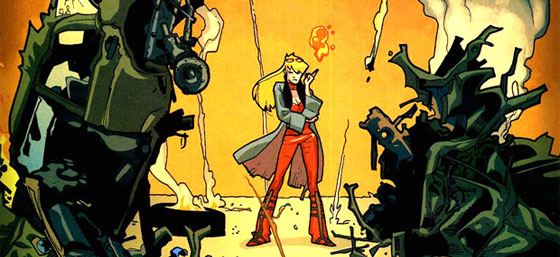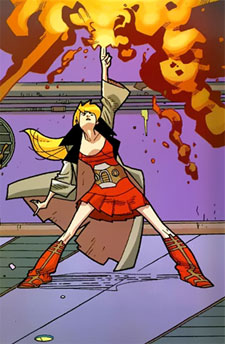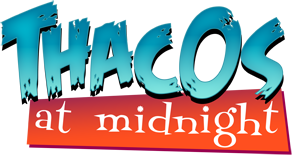
My gaming group recently played through the beginning of the new Annihilation event book. I wanted to change up the character I was playing and, having both read Nextwave and received 50 State Initiative recently, decided on Tabitha Smith. A snarky, impulsive young hero who could be translated to space easily enough. Seemed like the perfect answer to me.
Her Datafile, however, is an exercise in “Marvel Heroic Roleplaying in Miniature”. She has a one power set with one power and a tiny amount of specialties at Expert. Tabitha’s Datafile is not completely unique in the system. There are a handful of characters with a similar build; Cyclops, Amadeus Cho and Elixir are also limited to one dice in a single power set. All of their Datafiles look uncomfortably empty compared to the majority of Datafiles in the system. It’s almost like they’re designed to be overlooked by players.
This lead to me considering what place is there in the system for these characters, both in a narrative and gameplay sense, and what’s the best way to get the most out of the characters. It’s easy to write these off as sets for people new to the system since not much thought needs to be put into building a dice pool. On further reflection, they aren’t quite beginner or advanced Datafiles but need to be approached with a slightly different mindset.
I’ll be looking specifically at Tabitha Smith’s Datafile, but many of these ideas apply to the rest of this peculiar group with some adjustments for varying SFXs and limits.
 A solid strategy in Marvel Heroic Roleplaying is to build out your dice pool in the number of dice rather than just the size of the dice. Typically, a pool with a lot of smaller dice is more robust than a small pool of larger dice. There’s no reason why Psionic Time Bombs should be providing only one d10; all of the SFXs are built to add dice, depending on the situation.
A solid strategy in Marvel Heroic Roleplaying is to build out your dice pool in the number of dice rather than just the size of the dice. Typically, a pool with a lot of smaller dice is more robust than a small pool of larger dice. There’s no reason why Psionic Time Bombs should be providing only one d10; all of the SFXs are built to add dice, depending on the situation.
Area Attack and Tick, Tick—Boom! allow Tabitha to gain additional d6s when targeting multiple targets or making assets, respectively. A d6 might not seem like anything special, but a 6 on a d6 is more useful than a 2 on a d10. Plus, they give Tabitha the potential for maintaining a decent total when the d8s and d10s roll ones.
Big Bombs can be stepped up instead of doubling, but the standard dice pool size for Tabitha means that she’ll usually benefit more from doubling the d10 than stepping up the d10 to a d12. While Big Bombs has the potential to add to the Doom Pool in a big way, there’s no reason to really hold back unless things have gone really south for the party.
Once you’ve gained 10 XP, it’ll be cost efficient to pick up Versatile as a SFX early on. This allows you to split the d10 into a 2d8 or 3d6 on your next roll for free, allowing Tabitha to fill out her dice pool even more for relatively cheap. I’d consider picking up Versatile before raising the dice sizes on Specialities and Concussive Blast.
The fabulous thing about Tabitha’s SFXs is that none of them cost Plot Points. This leaves the Plot Points free to be spent on other things, such as making sure that Big Bombs doesn’t fail by adding more dice to her total, adding stunts and activating opportunities.
If Tabitha is sitting on loads of Plot Points, spend those to add more Specialty dice to the pool. Crime pairs up well with Combat; not only do you know how to blow up a bad guy, you know exactly where to hit so they won’t see you coming. Covert might take a bit more thinking to fit into a situation, but would be great for making Resources in Transition Scenes.
Keeping this stream of Plot Points going takes a bit of planning. I’d expect Tabitha to use a Distinction at d4 fairly regularly to feed her Plot Point habit. Her starting Limit, Mutant, isn’t really that useful for gaining Plot Points and probably should be swapped out for a more handy one early. Having one only one power die means that shutdown Limits are a bigger gamble than normal; losing your power die takes out the whole power set. If you want to push your luck with the Doom Pool, Growing Dread will provide a steady stream of additional Plot Points and narratively works with Tabitha’s explosive nature. Just make sure to become good friends with players who can lower the Doom Pool.
This strategy is a bit more involved than what’s needed for other Datafiles, where dice pools can be build out with lots of dice in lots of power sets. It is conceivable for Tabitha to keep pace with more complicated characters with a little legwork. The big question, I suppose, is “Why bother?”
The answer I eventually came to was “Because I want to play this character”. That should always be the deciding factor in Marvel Heroic Roleplaying.
One of the defining elements of Marvel Heroic Roleplaying is how the game balances powers. A common point of discussion on the topic of balance is how, for example, the Hulk with his d10s and d12s, is balanced with Spider-Man, a character with lots of d8s and a few d10s. Spider-Man might have to work on raising his effect die, but isn’t shut out completely. There isn’t a major advantage to having a party of Hulk, Thor and Sentry simply because they have lots of d12s.
What isn’t often discussed is how characters with one defining power fit in the game balance. Tabitha, Cyclops, Amadeus, and Elixir all have their power die at d10, which is respectable, but they need to increase their odds of success by growing their dice pools. Narratively, there’s one thing they can do and they can do it well, if they put forth the effort to do so. It means that the same power set needs to be used in every roll, but that also gives the player an excuse to stunt often and get descriptive. In the example of Tabitha, every roll is about blowing up something new in increasingly more bizarre ways.
It’s a different way to approach the game than what can be found in more standard Datafiles. I don’t know if I prefer it to having lots of fiddly powers, but as someone who likes impulsive characters, it was great fun for a session and an interesting exercise in testing the limits of the system.
